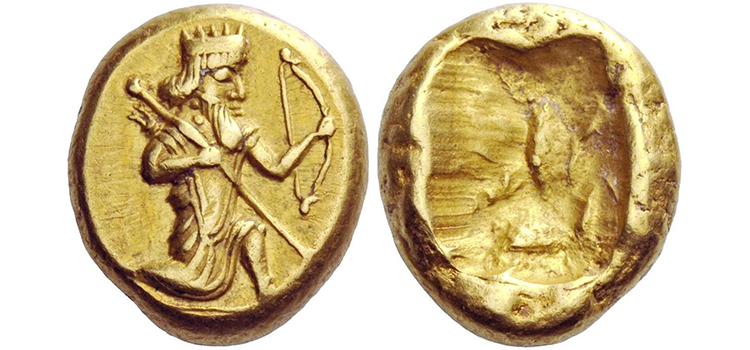Darics of Persia’s Achaemenid Empire
A silver or gold coin that might have circulated to pay for troops and supplies during the first Persian invasion of Greece between 492 BC and 490BC represents this important period of the history of western civilization.

The invasion ended in failure for the Persians at the battle of Marathon. However, the Persians added new territory and Eretria had been punished for supporting Ionia in their revolt against the Persians.
The success at Marathon was a great victory for the Greeks, particularly for Athens which began a “golden age.” The victory demonstrated that the Persians could be defeated by a united Greece which is exactly what Alexander the Great would do over a century and a half later.
Evolution of the Daric
Under the reign of the Achaemenid Empire, the coinage of the ancient world underwent another transformation. The Persian coins, known as darics, were inspired by the Lydians’ first coins but featured their own unique image — the figure of Persia’s Great King.
King Darius I, who reigned from 522 to 486 B.C., launched the new Persian currency. The first coins, known as siglos, were comprised of silver. When the design was changed to a kneeling archer, the coins were also minted in gold. The gold coins were known as darics, which does not refer to King Darius but rather was likely derived from the Old Persian Daruiyaka, meaning “Golden.” The gold coins weighed 8.36 grams, which was slightly more than the Croesus Stater. Instead of a double punch, the coins featured a single, oblong reverse punch.
The darics and siglos were likely minted in Sardis, Lydia. However, they circulated throughout the Persian Empire. The design of the coins changed during the course of the Achaemenid Empire, with rulers putting their own spin on the king design. E.S.G. Robinson cataloged the darics into four types:
- Type I Torso of bearded archer with the crenellated crown (kídaris) and sleeved chiton, facing right, a bow in the left hand and two arrows in the right.
- Type II Kneeling archer dressed as on Type I, facing right, with drawn bow and a quiver on his back.
- Type III The archer as on Type I but running with bent knees, moving to the right, with a bow in his left hand, a lance in his right, and a quiver on his back.
- Type IV The archer as on Type III, in same position moving to the right, with a bow in his left hand, a dagger in his right, and a quiver on his back.
While the obverse of the coins varied, the coins’ reverse always featured the mark of a utilitarian incuse punch.
Importance of Coins to Persian Empire
The Persian Empire was successful because it did not force the people it conquered to assimilate. Rather, they could maintain their own customs. Nonetheless, the Persian coinage united the empire. The daric became the first ancient gold coin to be widely used around the world. It was also one of the most recognizable coins of the ancient world. The coins are even referenced in the Old Testament.
The Achaemenid Empire relied on paid mercenaries. Soldiers in the Persian army were paid in darics. According to historians, each soldier received one daric per month.
Alexander the Great conquered the Persian Empire in the 330s B.C. However, the darics were still produced until they were eventually replaced by Alexander’s Stater around 300 B.C.
